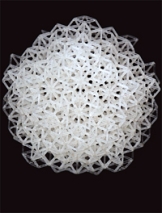researchers have constructed a three-dimensional model of a quasicrystal made from polymer rods to test whether such structures are useful for controlling the path of light in photonic circuits.
A quasicrystal is an unusual form of solid composed of two groups of atoms that repeat regularly throughout the structure with two different spacings. Unlike ordinary crystals that are made from a single building block that repeats with all equal spacings.
Ordinary crystals had been considered the best structure for making junctions in photonic circuits. But the researchers proved for the first time that quasicrystal structures are better for trapping and redirecting light because their structure is more nearly spherical.
The finding represents an advance for the burgeoning field of photonics - in which light is used to transmit and process information - and could lead to the development of faster telecommunications and computing devices.
"The search for a structure that blocks the passage of light in all directions has fascinated physicists and engineers for the past two decades," said

To conduct their experiment, the researchers constructed the world's first model of a three-dimensional photonic quasicrystal, which was a little larger than a softball and made from 4,000 centimetre-long polymer rods.
They observed how microwaves were blocked at certain angles in order to gauge how well the structure would control light passing through it.
Building the physical model was a breakthrough that proved more valuable than using complex mathematical calculations, which had been a hurdle in previous efforts to evaluate the effectiveness of photonic quasicrystals in blocking light.
"The pattern in which photons are blocked or not blocked had never really been computed," Steinhardt said. "In the laboratory, we were able to construct a device that was effectively like doing a computer simulation to see the patterns of transmission."
The researchers are now exploring ways of miniaturising the structure in order to use the device with visible light instead of microwaves. They also are examining whether the quasicrystal designs may be useful in electronic and acoustic applications.




Project to investigate hybrid approach to titanium manufacturing
What is this a hybrid of? Superplastic forming tends to be performed slowly as otherwise the behaviour is the hot creep that typifies hot...